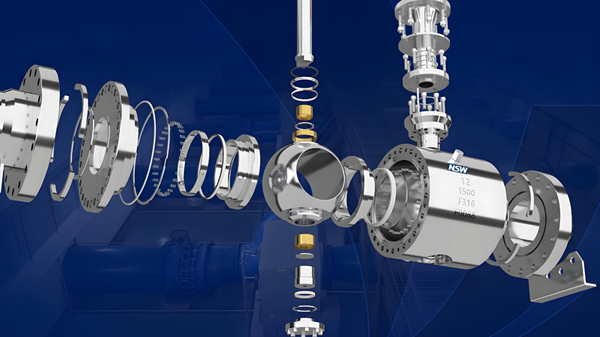There are significant differences between Trunnion ball valves and Floating ball valves in terms of structure, working principle, performance and application occasions. The following is a detailed comparison of the two:
Structural Differences of Trunnion and Floating Ball Valve
Trunnion Ball Valve
- The ball is fixedly connected to the upper and lower valve stems. The ball can only rotate around the axis of the valve stem and cannot move freely in the valve body.
- The upper and lower valve stems are firmly connected to the ball, which jointly restricts the movement of the ball.
Floating Ball Valve
- The ball is floating, that is, there is no fixed connection between the ball and the valve seat, and the ball can move freely in the valve body.
- Usually only one lower valve stem is connected to the ball, and the upper valve stem generally only plays the role of transmitting torque and is not directly fixed to the ball.
Working Principle
1. Trunnion ball valve
- The tight fit and seal between the ball and the valve seat are achieved through the preload between the ball and the valve seat and the transmission of the valve stem.
- Torque is evenly transmitted to the ball through the upper and lower valve stems, and the rotation of the ball is smoother and the force is more even.
2. Floating ball valve
- When closed, the medium pressure pushes the ball to the outlet valve seat, so that the ball and the valve seat fit tightly to achieve sealing. The greater the medium pressure, the better the sealing effect.
- Torque is mainly transmitted to the ball through the lower valve stem, and the upper valve stem assists in transmission. During the opening and closing process, the force situation of the ball is relatively complex.
Performance Characteristics
1. Trunnion ball valve
- Stable sealing performance, not affected by medium pressure fluctuations.
- The structure is relatively complex, the overall appearance is slightly sturdy, and the valve body is usually thicker.
- Suitable for high-pressure, large-diameter pipeline systems, and occasions with high requirements for sealing performance and flow control.
2. Floating ball valve
- When the medium pressure is low or there is no medium pressure, the sealing performance may be affected to a certain extent.
- The overall structure is relatively simple, the appearance is compact, and the volume is usually small.
- Commonly used in medium and low pressure, small diameter pipeline systems, as well as occasions with high requirements for medium cleanliness and relatively stable medium pressure.
Applications
1. Trunnion ball valve
More suitable for high pressure, large diameter occasions, such as key pipeline systems in petrochemical, natural gas transmission, power and other industries.
Suitable for occasions requiring two-way sealing, because the valve seat design of the fixed ball valve can ensure sealing in both directions.
2. Floating ball valve
Widely used in chemical, petroleum, natural gas and metallurgical industries, especially for long-distance natural gas pipelines containing hydrogen sulfide media, impurities or severe corrosion.
Also suitable for occasions with high requirements for medium cleanliness and relatively stable medium pressure, such as ordinary water supply and drainage systems, air conditioning systems, etc.
In summary
Trunnion ball valves and floating ball valves each have their own unique structure and performance characteristics, suitable for different applications. When choosing, comprehensive consideration should be given to factors such as specific working conditions, medium characteristics and sealing performance requirements.
Post time: Feb-10-2025







